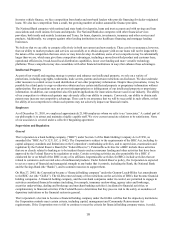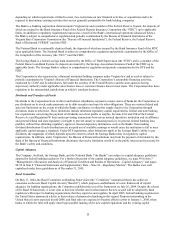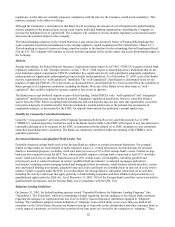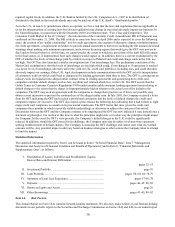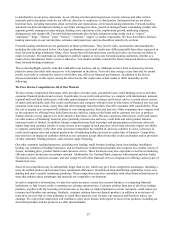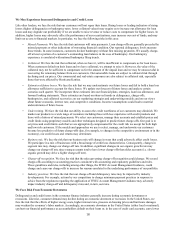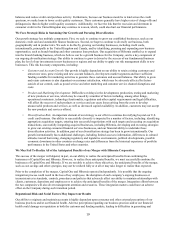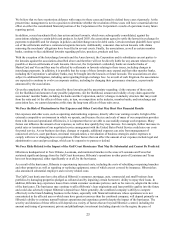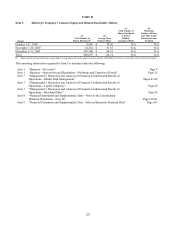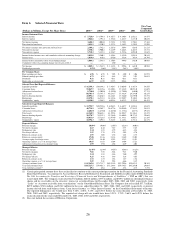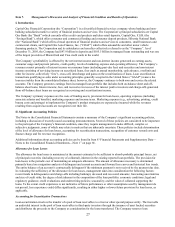Capital One 2005 Annual Report Download - page 27
Download and view the complete annual report
Please find page 27 of the 2005 Capital One annual report below. You can navigate through the pages in the report by either clicking on the pages listed below, or by using the keyword search tool below to find specific information within the annual report.W
e May Experience Increased Delinquencies and Credit Losses
Like other lenders, we face the risk that our customers will not repay their loans. Rising losses or leading indicators of rising
losses (higher delinquencies or bankruptcy rates; lower collateral values) may require us to increase our allowance for loan
losses and may degrade our profitability if we are unable to raise revenue or reduce costs to compensate for higher losses. In
addition, higher losses may adversely affect the performance of our securitizations, may increase our cost of funds, and may
mit our access to financial markets. In particular, we face the following risks in this area: li
• Missed Payments. We face the risk that customers will miss payments. Loan charge-offs are generally preceded by
missed payments or other indications of worsening financial condition. Our reported delinquency levels measure
these trends. In some instances, customers declare bankruptcy without first missing payments. We usually charge-
off at least a portion of a customer’ s outstanding loan balance in the case of bankruptcy. Our bankruptcy
experience is correlated with national bankruptcy filing trends.
• Collateral. We face the risk that collateral, when we have it, will be insufficient to compensate us for loan losses.
When customers default on their loans and we have collateral, we attempt to seize it. However, the value of the
collateral may not be sufficient to compensate us for the amount of the unpaid loan and we may be unsuccessful in
recovering the remaining balance from our customers. Our automobile loans are subject to collateral risk through
declining used car prices. Our commercial and real-estate exposures are also subject to collateral risk, especially
those that were affected by Hurricane Katrina.
• Estimates of future losses. We face the risk that we may underestimate our future losses and fail to hold a loan loss
allowance sufficient to account for these losses. We update our forecast of future losses and analyze certain
scenarios each quarter. We incorporate these estimates into our financial plans, strategies, loan loss allowance, and
forward looking statements. These estimates are based on observed trends in delinquency, charge-offs,
bankruptcies, and collateral recoveries; on our marketing strategies and underwriting models; and on our views
about future economic, interest rate, and competitive conditions. Incorrect assumptions could lead to material
underestimates of future losses.
• Underwriting. We face the risk that our ability to assess the credit worthiness of our customers may diminish. We
market our products to a wide range of customers including those with less experience with credit products and
those with a history of missed payments. We select our customers, manage their accounts and establish prices and
credit limits using proprietary models and other techniques designed to predict future charge-offs. Our goal is to
set prices and credit limits such that we are appropriately compensated for the credit risk we accept for both high
and low risk customers. If the models and approaches we use to select, manage, and underwrite our customers
become less predictive of future charge-offs (due, for example, to changes in the competitive environment or in the
economy), our credit losses and returns may deteriorate.
• Business mix. We face the risk that our business mix will change in ways that could adversely affect credit losses.
We participate in a mix of businesses with a broad range of credit loss characteristics. Consequently, changes in
segment mix may change our charge-off rate. In addition, significant changes in our organic growth rate may
change our charge-off rate since young accounts tend to have lower charge-offs than older accounts (i.e. slower
organic growth may drive a higher charge-off rate).
• Charge-off recognition. We face the risk that the rules governing charge-off recognition could change. We record
charge-offs according to accounting practices consistent with accounting and regulatory guidelines and rules.
These guidelines and rules, including among other things, the FFIEC Account Management Guidance, could
change and cause our charge-offs to increase for reasons unrelated to the underlying performance of our portfolio.
• Industry practices. We face the risk that our charge-off and delinquency rates may be impacted by industry
developments. For example, actions by our competitors to change minimum payment practices in response to
advice from the regulators regarding the application of FFIEC Account Management Guidance may adversely
impact industry charge-off and delinquency rates and, in turn, our rates.
W
e Face Risk From Economic Downturns
Delinquencies and credit losses in the consumer finance industry generally increase during economic downturns or
recessions. Likewise, consumer demand may decline during an economic downturn or recession. In the United States, we
face the risk that the effects of higher energy costs, higher interest rates, pressure on housing prices and hurricane damages
may weaken the economy’ s labor markets. Accordingly, an economic downturn in the United States (either local or national),
can hurt our financial performance as accountholders default on their loans or, in the case of credit card accounts, carry lower
18




